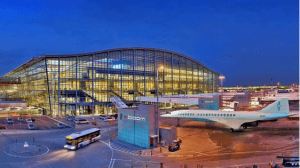A Denver-based startup company is entering the race to reintroduce supersonic commercial travel with the promise of a 40-passenger airliner that can not only fly faster than Concorde, but at business class prices. Boom Technology says it is using modern engines and materials to develop a supersonic passenger jet that can cruise at Mach 2.2 (1,675 mph, 2,700 km/h), with prices starting at US$5,000 for a return ticket between London and New York.
When the two Concorde fleets were grounded in 2003, aviation took a giant step backwards. However, it may not be a permanent setback with NASA starting development on a new supersonic X-plane and various companies testing the supersonic waters. This would be encouraging if it weren’t for the fact that the Concorde was anything but a bargain. It may have been able to carry up to 128 passengers at Mach 2 (1,500 mph, 2,450 km/h), but the average round trip price from London to New York was $12,000.
With headquarters at Centennial Airport near Denver, Boom Technology believes that it can build a new supersonic passenger jet in just a few years that will not only be faster, but also cheaper than its predecessor. The finished product is projected to carry 40 passengers in two single-seat rows of standard first-class seats at a cruising altitude of 60,000 ft (18,000 m) and a speed of Mach 2.2.
In a report in Bloomberg Business, Boom said that it’s only been in the last 10 years that the technology became available to make a Concorde replacement practical. Thanks to new advances in aerodynamics, composites, engines, wind tunnels, and software, Boom believes that it’s possible to make a plane that can fly from London to New York in 3.6 hours at a cost of $5,000 for round trip.
 According to Boom, carbon composites can withstand higher temperatures than the aluminium alloys used in Concorde, yet are cheaper than the titanium and other exotic alloys used in military aircraft. They’re also lighter, which allows the aircraft to fly faster and more efficiently. Combined with advanced engines, the company believes that the finished product will be 30 percent more efficient than Concorde, and that through the use of computer simulations development can be achieved in record time.
According to Boom, carbon composites can withstand higher temperatures than the aluminium alloys used in Concorde, yet are cheaper than the titanium and other exotic alloys used in military aircraft. They’re also lighter, which allows the aircraft to fly faster and more efficiently. Combined with advanced engines, the company believes that the finished product will be 30 percent more efficient than Concorde, and that through the use of computer simulations development can be achieved in record time.
So far, the Boom project hasn’t gone much beyond artist’s concepts and some wooden mock ups, but the company says that it will have a development prototype ready for a first flight late next year to be followed by supersonic testing at Edwards Air Force Base in California. However, supersonic aircraft are still on the cutting edge of aerospace technology with a lot of surprises (especially when it comes to costs), so it remains to be seen whether it will be Boom or bust.

